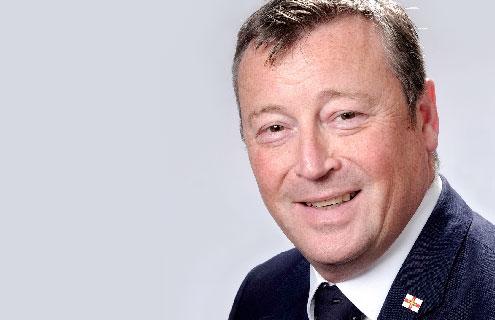Guernsey Finance
With the recent pick up in captive interest driving activity across the sector, Dominic Wheatley discusses what Guernsey Finance is currently working on
What is currently happening in Guernsey’s captive insurance market?
Guernsey is currently seeing significant levels of renewed interest as the market is hardening in the commercial insurance markets and that started with catastrophe level reinsurance with rates increasing. This is unsurprising because 2017 was a really bad year for catastrophic losses, followed by 2018 and this year we have also had a couple of hurricanes—so firms are starting to adjust models and rates are starting to harden. These factors all affect the whole market and once you start to see these in the commercial market you will see these feed through to other lines of business, particularly around the big risks. From this, Guernsey has started to see an uptick in new inquiries and we are already seeing some formations off the back of that.
Behind the scenes, there is still increasing interest in lines of business that have been gathering pace as captive lines, such as employee benefits insurances, cyber risk, and other types of emerging risks. There is definitely increasing interest towards using captives more.
With captive interest picking up, what is Guernsey Finance working on in the captive space?
The recent pick up in captive interest is certainly driving activity across the sector and Guernsey Finance is providing support to our industry. As a jurisdiction, we are looking at how captive usage is changing in response to current trends and how Guernsey can address the changing demands of captive users. One interesting development we are seeing is growing interest in captives among private company owners and high net worth families, which brings together Guernsey’s expertise in wealth management and our pre-eminence in international and strategic captives.
Our promotional work focuses on making sure that the market understands our unique combination of reputational features as an offshore insurance centre. Our corporation tax regime is endorsed by both the Organisation for Economic Co-operation and Development (OECD) and the EU as fully compliant with international standards in fair tax competition and economic substance. The EU anti-money laundering (AML) inspectorate, Moneyval, has assessed our levels of compliance with the Financial Action Task Force (FATF)’s AML principles as being number one in the world. And the International Association of Insurance Supervisors found us to be fully compliant with their global standards of insurance regulation. No other captive jurisdiction offers this combination internationally endorsed standards of business conduct.
We also emphasise our close links with London, the centre of global insurance, and our community of over 1,000 professionals delivering expert advice and excellence of service to our international clients. We are the best at international captive insurance for compelling reasons.
How is the European regulatory environment for captive insurance affecting Guernsey?
The EU’s Solvency II environment is not conducive to captive insurers, focusing as it does on systemic risk and policyholder protection, neither of which are key risks in a captive insurance context. We are seeing significant levels of interest in relocating captive operations from EU captive centres to Guernsey. I would expect this trend to continue as Brexit progresses.
Over the last few years, Guernsey Finance has worked closely with the Asian market, in terms of captive insurance education. How is this progressing?
We now have three Chinese-owned captives and a significant number of prospects from China, Hong Kong and, indeed, elsewhere in South East Asia. Just a couple of weeks ago we ran a captive masterclass event in Shanghai with more than 80 attendees, so interest is strong and growing.
What is Guernsey working on right now in the insurance-linked securities (ILS) market? What trends are you seeing?
The most significant step we have taken for the development of the sector in Guernsey is the rollover concept, where, subject to certain positions and regulatory approval, the annual renewals process can be rolled over, and there is a 30-day period within which an ILS manager can have theoretically two exposures, funded by one set of capital.
However, the reality is that you do not have two exposures because one of them is off risk and one is on risk, the date on which you transfer capital is not always the same as the date at which the liability switches.
This is an administrative issue, and the regulator recognises that.
The Guernsey Financial Services Commission (GFSC) has, therefore, put in place a specific regime that, providing certain criteria are met, they will allow up to 30 days to transfer capital.
That has been quite an advancement to the industry and is making life a lot easier for the ILS industry in Guernsey. Increasingly it is being recognised worldwide as a significant innovation, making ILS more effective and efficient.
Secondly, Guernsey has taken advantage of the fact that the island is not only an insurance centre but also a major funds centre, particularly in alternative assets.
Over the past year, we have brought these two capabilities together and designed a single structure that can be licensed for both insurance and investment. This promises significant savings in terms of both cost and process and is attracting considerable interest.
It has only come in this year but we are hoping to see the first businesses coming in for the end of year renewal season.
How do you see the ILS market changing in the next 12 months?
To some extent, the market got “lucky” with Hurricane Dorian, which at the last minute missed most of America, as another major loss could have had some impact on investors, particularly following 2017 and 2018.
We would like to see the emergence of a reasonably stable model that allows investors to have greater levels of confidence in the type of risk profile that they’re investing in.
The two back-to-back difficult years that we have had have just undermined a little bit of the confidence people have in the existing catastrophe models.
On the technical side, our industry is very pleased with the developments we have made in the past year, and are still focused on promoting those.
Obviously there will be further developments in due course—Guernsey is well known for its enthusiasm for innovation in this market.

.jpg)



